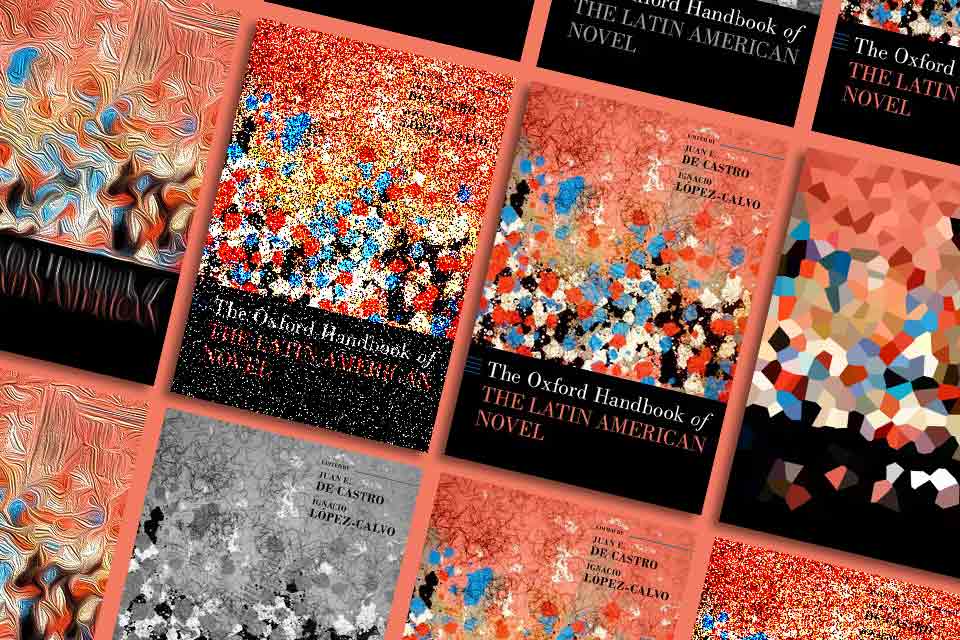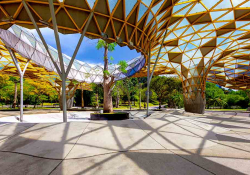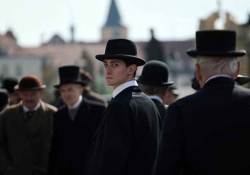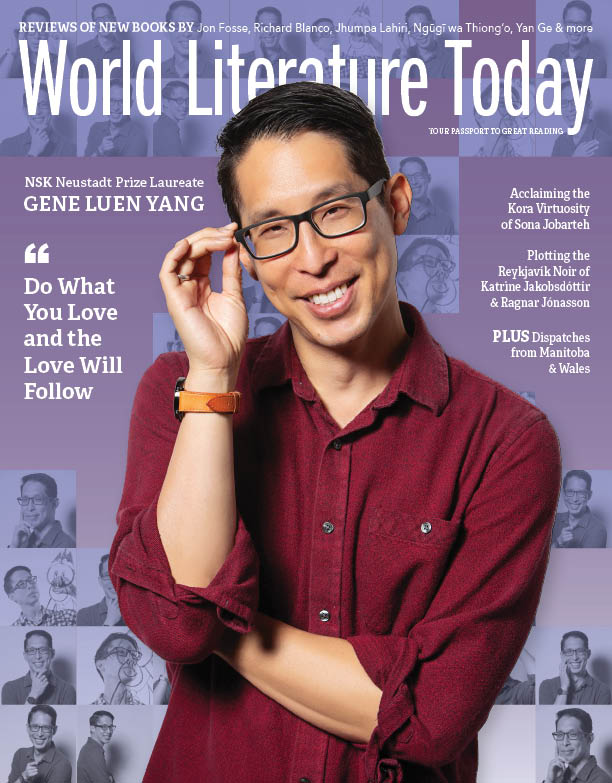The West’s “Other” World Novel
 Even though the Latin American novel was never the West’s “Other,” the new Handbook published by Oxford University Press does a marvelous job of producing a sorely needed remapping of the continent’s contributions to the genre.
Even though the Latin American novel was never the West’s “Other,” the new Handbook published by Oxford University Press does a marvelous job of producing a sorely needed remapping of the continent’s contributions to the genre.
When analyses of the novel, Western or not, can be hastily outsourced, (re)invented or repurposed by AI, The Oxford Handbook of the Latin American Novel’s accessibility is propitious. This is also a time when national outlines and thematic studies of a genre shared across cultures for millennia conflate, while hybridity and an eroding sense of authorial agency spur the questioning of its relation to other forms, with motley gatekeepers marshaling its demise. Editors Juan E. De Castro and Ignacio López-Calvo wade into that maelstrom heralding continental values without chauvinism, simplifications, or triumphalism. Not a dress rehearsal for a history of the Latin American novel (LAN) or a catch-all assessment of the myriad topics informing it, this inclusive volume is state of the art, with revealing contributions by newer scholars. There is no equivalent or precursor in the major languages for LAN criticism, and as such the Oxford Handbook deserves great attention.
Impressive and daunting, its critics paying attention to well-known or new novels, many essays channel Rachel Cusk’s assertion in a 2020 Paris Review interview: “You build a novel. You have to build it like a building so that it stays standing when you’re not in it.” This outsized edifice (868 large-format pages) offers tenancy to Latin Americanists and audiences interested in world literature and its distillations. The editors succinctly introduce forty-five essays systematized into seven parts, with more space allotted to the history of the novel (part 1) and representative individual novelists from the twentieth and twenty-first centuries (part 6, although many reappear interspersed). Reasonably, not all contributions are groundbreaking, immersive, or deft, and in part 1 some established scholars, who needed editing, are at pains to update previous work. Nevertheless, numerous essays illustrate the diverse cultural legacies and disputed heritages that frame the analyzed texts.
This outsized edifice offers tenancy to Latin Americanists and audiences interested in world literature and its distillations.
Part 4’s chapters negotiate reliance on time-honored scholarship and recent critical categories for studying gender and sexuality. The most successful is on the nineteenth century for its succinct discussion of those overarching concerns vis-à-vis the nation. The twentieth-century chapter, focused on feminism, leaves the impression that a few canonical works or themes define women’s novels, when a whole chapter might be devoted to the female gaze that empowers women novelists. A less judicious chapter on LGBTQ novels limits the range of authors like Cristina Rivera Garza with that acronym, and the nebulous “neofantastic queer” privileges agendas that unclassifiable novels like Mario Bellatin’s or César Aira’s (not discussed) subvert. Deifying DEI positioning decontextualizes progress and discriminates, eliding novel contributions to untried forms. Narrative nonfiction by María Moreno, María Gainza, Fernanda Melchor, Carolina Sanín, and particularly Ariana Harwicz would have enhanced the last two chapters. A Latin American LGBTQ motto is fitting: A tu teoría le falta calle, i.e., you need to get out and learn to avoid academic naïveté.
The last part, on LAN’s worldwide reception, has immense extraterritorial value. Whether one agrees or not with these critics’ choice of representative authors, they are better at making themselves understood than some who are theory-bound by stretching their own concepts and being more interested in analyzing developments and trends. Roberto Ignacio Díaz’s historical approach can be deepened by considering journalism by Rubén Darío and his peers in the nineteenth century, and in the twentieth by Vicente Huidobro’s collaborations or Severo Sarduy’s promotional work at Le Seuil. Like Pascale Casanova’s, Jacques Leenhardt’s criticism is crucial for understanding the relations Díaz dissects. Nicholas Birns’s comprehensive analysis of LAN’s worldwide influence requires fine-tuning for the reception in Spanish of Valeria Luiselli, or Guadalupe Nettel’s in France; and a chapter on German, Italian, or Indian receptions would have added perspective. Benjamin Loy bravely takes on received ideas and critics, remapping LAN in terms of translation, although skipping the role of German studies in these matters.
In general, the more ambitious essays are well reasoned and researched, yet the few references to Ángel Rama, the most canonical critic of the twentieth century’s second half, ignore his sedulous “Diez problemas para el novelista latinoamericano” (1964) or “Tecnificación de la narrativa” (1981), collected in La novela en América Latina: Panoramas 1920–1980 (1986). One need not carry a specific torch to ascertain that Rama, who wrote with real bounce when theory was becoming less uniform, remains unparalleled as a critic of the novel. If some chapters explain his working terms and core tenets, few manage to exemplify them. Some, like José Eduardo González, disregard those writings, about which there is no quibbling. More thoughtfulness is devoted to his problematic Transculturación narrativa en América Latina (1982) or the posthumous La ciudad letrada (1984, Eng. The Lettered City, 1996), while there is one mention of the posthumous 1986 compilation.
Many of the Handbook’s essays excel at disentangling the conceptual premises of previous critical traditions, avoiding sweeping generalizations and period detail.
Conversely, many essays excel at disentangling the conceptual premises of previous critical traditions, avoiding sweeping generalizations and period detail. Factoring in that just about every important contemporary novelist or novel is discussed, and that the continent’s social and political diversity offers an unmatched panoply for “world literature,” many chapters in part 2 (Space) are rightly ambitious and illuminating, like Martin Camps’s on modernity in the Mexican novel, the one on the Southern Cone, the two-century outline of the Brazilian novel (the pieces on that region are uniformly fine), and Núria Vilanova’s on the Andean novel, which rightly nuances Colombian production within that space. The chapters on the Central American and Spanish-language Caribbean novels could have devoted space to Venezuelan novelists now settled abroad.
It is challenging to examine narrative trends, as part 5 attempts, because of ongoing developments in narratology and the popularity of Walter Benjamin’s ideas (wisely frequented by Anadeli Bencomo on Juan Rulfo). Nevertheless, Helene C. Weldt-Basson does a masterful job explaining the historical novel through the lens of the dictator(ship) novel, as does Persephone Braham on a too widely conceived corpus of popular fictions (i.e., detective and science fiction). If, under the rubric “fantasy,” Braham circumvents literature of the fantastic, one of the continent’s distinguishable contributions, Amaryll Chanady’s chapter on magical realism (a renowned worldwide achievement) and the marvelous real resorts to commonplaces, like the chapter on the Other in part 1. If Andreas Kurz’s chapter on the experimental novel omits relevant novels like Enrique Lihn’s Batman en Chile (1973), and Melissa Fitch’s on technology overlooks Rama, it is disappointing that both ignore influential critical and narrative work by Héctor Libertella and José Balza.
Editors can correct style, question ideological overreach or extension, even hyperbole. But the ideas and ideals are not theirs, and De Castro and López-Calvo deserve praise for finding the proper contributors, because countless critics address these topics in stand-alone essays or diatribes directed to like-minded audiences hardly worried about incisive appraisals. The Oxford Handbook of the Latin American Novel’s success and benefits rely on contesting received knowledge. However, the elephants in the classroom (its main audience) are language-based inconsistencies, cultural lapses, misinterpretations, and a lack of direct dialogue with native scholarly traditions. In Professing Criticism (2022), John Guillory advocates persuasively for widening and democratizing contemporary “English-only” curricula, whose discrepancies and contradictions are “a question less of who best represents the depredations of colonialism or the anticolonial struggle than of the use to which writers on the global scene have put the English language, as an agent of global interconnection.”
Respected Latin Americanists and informed world literature critics like Rama, Emir Rodríguez Monegal, Christopher Domínguez Michael, Pedro Henríquez Ureña, and the Spaniards Guillermo de Torre and Ignacio Echevarría (both unmentioned) never take cover in gauzy abstraction; so, do not expect the visceral avowals that reveal what critics would ultimately like to see here. Thus, the list of critics missing in action is substantial. From a native perspective, and recalling their world literature views: Claudia Gilman (on intellectuals, critics of the “boom,” the Cuban Revolution); John Brushwood (thorough albeit conventional on the twentieth-century novel); Luis Harss’s Into the Meanstream, whose polemical Spanish version is still discussed; Jean Franco’s early advocacy of LAN’s diffusion in the anglophone world; Julio Ortega’s similar role in the US and Spain; Noé Jitrik’s or Josefina Ludmer’s contributions to novelistic theory, or Jorge Ruffinelli’s essays, all ignored. Very useful analyses in this century by Becerra, Fornet, and Guerrero are equally overlooked.
The lack of references to influential compilations can be remedied with La novela iberoamericana (1968), La novela hispanoamericana (1969–72), and Novelistas hispanoamericanos de hoy (1976), plus, more recently, The Contemporary Spanish-American Novel: Bolaño and After (2013). Richer results would also have been accomplished by probing the twelve volumes of Historia crítica de la literatura argentina; the three of América Latina: Palavra, Literatura e Cultura, Oxford’s or Cambridge’s volumes on Latin American literature, and Cartografía occidental de la novela, all published during the last quarter-century, along with similar earlier initiatives in Spain and the Americas, including thematic proceedings of Latin Americanist conferences. A history of the abundant histories of the novel, and an outline of the failed attempts to inscribe an autochthonous [sic] Latin American theory of the genre, would have been most useful (one of them might be right) when the recentness of some Panglossian attempts is the strength and weakness that dates them.
One might quibble over how much those studies, or earlier ones like the seminal América Latina en su literatura (1972, Eng. 1980), decipher the culture of the novel, but consulting them prevents discovering gunpowder or dismissing critical forerunners or traditions not produced in one critic’s bailiwick or emphasized in another’s training. Similarly, working with the two pivotal volumes of Los novelistas como críticos (1991), which historicize two centuries of eloquent nonfiction about the novel, free of sentimentality, would have been constructive. Equally productive, there are numerous uncollected pieces, in Spanish, by novelists whose contrarian views ask for a moratorium on violence, Otherness, drug trafficking, autobiographical stories that no one misses, and, more daringly, novels against patriarchy and sexual normativity. That is against the anglophone critical grain. But should critics not confront views that are not standard, like Ariana Harwicz’s or Mariana Enríquez’s, who challenge politically correct aesthetic dogmas in a steely but not spiteful way?
De Castro accurately speaks of the “flattening” of the novel in the 1960s and ’70s. Departing from that period, noticeably absent topics include: (1) ethics, (2) novelizing the lives of world scientists to relay existential threats to humanity, (3) the purportedly apolitical nature of the new novelists or their works, (4) connecting the rise of personal brands and the toxic cultures of online fandom vis-à-vis defining quintessential millennial novels, (5) how to read the archive or “boom” novels in the twenty-first century, (6) the total novel (mentioned in passing, despite significant criticism in English and Spanish), (7) comparative literature methods to put “first world” novels in perspective, (8) a register of more than “promising” novelists, (9) how hyperbolic media like BookTok change how novels are recommended and sold, (10) the new wave of Latin American novelists who write from Spain and concomitant criticism from that country, (11) Latino US-based novelists who prefer to write in Spanish, and (12) inverting influences beyond Faulkner and Joyce.
Some topics demand more rigorous engagement, such as the coherence of patterning narrative, or revisiting the prevalence of Marxist ideas, now more aligned with popular novelty and critical intransigence than with Marx’s aesthetic views. Regarding missing authors—a checklist is impractical yet useful when dealing with some of the all-encompassing registers—the Andean region can be accurately represented by examining Colombia’s Mario Mendoza, Peru’s Miguel Gutiérrez and Edgardo Rivera Martínez, Ecuador’s Javier Vásconez and Leonardo Valencia, and Bolivia’s Jaime Sáenz, who merits more than a brief mention in part 2. That domain is a more complex problem in the Southern Cone, with the very strong influence and reception of Mario Levrero, unacknowledged, even when some chapters are punctuated by anecdotal information.
This handbook needs fewer amendments in the contemporary period (part 6), with excellent contributions by Rita de Maeseneer, Carolina Orloff, and Gene Bell-Villada, who thoughtfully intersperse native sources and an ethics of criticism. When other essays are constrained by overdependency on making a “theoretical” point and privileging made-to-order references, they resort to faddish critical tropes for alternative cartographies of the genre, shunning solid “local” interpretations. There is no mention of native works on the translation or reception of recent novelists into English, a topic slighted by Jonathan B. Monroe and others, even when there are pioneering studies on Roberto Bolaño or Junot Díaz, as de Maeseneer attests. Preferring a hegemonic language exempts critics from consolidating forces to find a new “new novel,” even by provocative authors, a cohort Ana Gallego Cuiñas discusses brilliantly in part 1.
A comprehensive volume like The Oxford Handbook of the Latin American Novel makes details granular, adding urgency to criticizing group thinking, even when seeking critical clarity creates a singular point of view or symmetries that the best novels, and novelists, reject. Still, the less felicitous essays are on Mario Vargas Llosa; the assertions, not arguments, on the Arab novel; the Caribbean novel; the chapter from part 1 on the postmodern and post-“boom” novels (it is obstructive to merely list many from different periods and extend those categories to Bolaño and his cohort); and, given the copious scholarship on the topic, the one on testimonial novels and autofiction lacks nuance. The weak, recycled views on the Afro-LAN and the decontextualized chapter on the Indigenous novel are fortunately salvaged by edifying chapters on the Jewish-LAN and the Asian-LAN by López-Calvo in part 2. For all the value of calling scholarly attention to Western domination, the problem lies in assuming the reliability of those accounts. There is honesty in the weaker chapters but overreliance on trite ideas.
The best readings add to novels’ afterlives and create a mental map without potted histories or institutional or personal subtexts.
The best readings add to novels’ afterlives and create a mental map without potted histories or institutional or personal subtexts, reshaping much-bandied boundaries. Many novels paradoxically give a feeling of closeness and intimacy while being puzzling and obscure. Interpreting them tends to focus on what they mean rather than on the experiences they create, making cognitive approaches, fairly absent here, ideal for understanding how novels “think.” That is, how they index thought, and how their readers differentiate between what characters and their creators think, a methodology present in Pavel, Bessière, Rancière, Moretti, Mazzoni and, after the publication of The Oxford Handbook of the Latin American Novel, Timothy Bewes on novels for a postfictional age. The infelicities noted matter less when realizing that in sum this is a masterly endeavor, unequalled in hypotheses and outcomes. De Castro, López-Calvo, and Oxford University Press have done a marvelous job of producing a sorely needed volume offering lasting contributions that remap what the West understands as the Latin American novel, even though it never was its “Other.”
San Francisco











